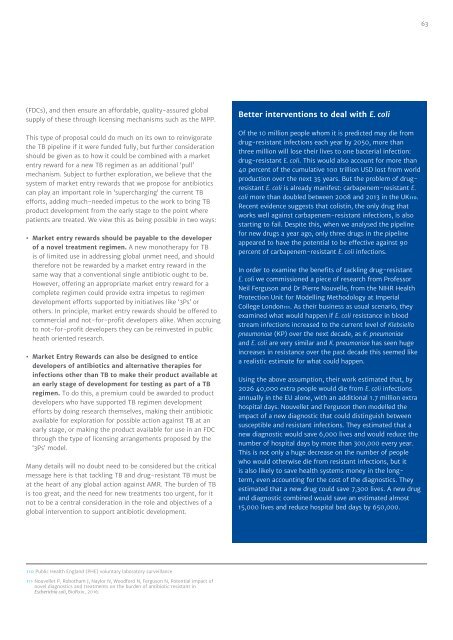TACKLING DRUG-RESISTANT INFECTIONS GLOBALLY FINAL REPORT AND RECOMMENDATIONS
qQvJ300ETXu
qQvJ300ETXu
You also want an ePaper? Increase the reach of your titles
YUMPU automatically turns print PDFs into web optimized ePapers that Google loves.
63<br />
(FDCs), and then ensure an affordable, quality-assured global<br />
supply of these through licensing mechanisms such as the MPP.<br />
This type of proposal could do much on its own to reinvigorate<br />
the TB pipeline if it were funded fully, but further consideration<br />
should be given as to how it could be combined with a market<br />
entry reward for a new TB regimen as an additional ‘pull’<br />
mechanism. Subject to further exploration, we believe that the<br />
system of market entry rewards that we propose for antibiotics<br />
can play an important role in ‘supercharging’ the current TB<br />
efforts, adding much-needed impetus to the work to bring TB<br />
product development from the early stage to the point where<br />
patients are treated. We view this as being possible in two ways:<br />
• Market entry rewards should be payable to the developer<br />
of a novel treatment regimen. A new monotherapy for TB<br />
is of limited use in addressing global unmet need, and should<br />
therefore not be rewarded by a market entry reward in the<br />
same way that a conventional single antibiotic ought to be.<br />
However, offering an appropriate market entry reward for a<br />
complete regimen could provide extra impetus to regimen<br />
development efforts supported by initiatives like ‘3Ps’ or<br />
others. In principle, market entry rewards should be offered to<br />
commercial and not-for-profit developers alike. When accruing<br />
to not-for-profit developers they can be reinvested in public<br />
heath oriented research.<br />
• Market Entry Rewards can also be designed to entice<br />
developers of antibiotics and alternative therapies for<br />
infections other than TB to make their product available at<br />
an early stage of development for testing as part of a TB<br />
regimen. To do this, a premium could be awarded to product<br />
developers who have supported TB regimen development<br />
efforts by doing research themselves, making their antibiotic<br />
available for exploration for possible action against TB at an<br />
early stage, or making the product available for use in an FDC<br />
through the type of licensing arrangements proposed by the<br />
‘3Ps’ model.<br />
Many details will no doubt need to be considered but the critical<br />
message here is that tackling TB and drug-resistant TB must be<br />
at the heart of any global action against AMR. The burden of TB<br />
is too great, and the need for new treatments too urgent, for it<br />
not to be a central consideration in the role and objectives of a<br />
global intervention to support antibiotic development.<br />
Better interventions to deal with E. coli<br />
Of the 10 million people whom it is predicted may die from<br />
drug-resistant infections each year by 2050, more than<br />
three million will lose their lives to one bacterial infection:<br />
drug-resistant E. coli. This would also account for more than<br />
40 percent of the cumulative 100 trillion USD lost from world<br />
production over the next 35 years. But the problem of drugresistant<br />
E. coli is already manifest: carbapenem-resistant E.<br />
coli more than doubled between 2008 and 2013 in the UK110.<br />
Recent evidence suggests that colistin, the only drug that<br />
works well against carbapenem-resistant infections, is also<br />
starting to fail. Despite this, when we analysed the pipeline<br />
for new drugs a year ago, only three drugs in the pipeline<br />
appeared to have the potential to be effective against 90<br />
percent of carbapenem-resistant E. coli infections.<br />
In order to examine the benefits of tackling drug-resistant<br />
E. coli we commissioned a piece of research from Professor<br />
Neil Ferguson and Dr Pierre Nouvelle, from the NIHR Health<br />
Protection Unit for Modelling Methodology at Imperial<br />
College London111. As their business as usual scenario, they<br />
examined what would happen if E. coli resistance in blood<br />
stream infections increased to the current level of Klebsiella<br />
pneumoniae (KP) over the next decade, as K. pneumoniae<br />
and E. coli are very similar and K. pneumoniae has seen huge<br />
increases in resistance over the past decade this seemed like<br />
a realistic estimate for what could happen.<br />
Using the above assumption, their work estimated that, by<br />
2026 40,000 extra people would die from E. coli infections<br />
annually in the EU alone, with an additional 1.7 million extra<br />
hospital days. Nouvellet and Ferguson then modelled the<br />
impact of a new diagnostic that could distinguish between<br />
susceptible and resistant infections. They estimated that a<br />
new diagnostic would save 6,000 lives and would reduce the<br />
number of hospital days by more than 300,000 every year.<br />
This is not only a huge decrease on the number of people<br />
who would otherwise die from resistant infections, but it<br />
is also likely to save health systems money in the longterm,<br />
even accounting for the cost of the diagnostics. They<br />
estimated that a new drug could save 7,300 lives. A new drug<br />
and diagnostic combined would save an estimated almost<br />
15,000 lives and reduce hospital bed days by 650,000.<br />
110 Public Health England (PHE) voluntary laboratory surveillance<br />
111 Nouvellet P, Robotham J, Naylor N, Woodford N, Ferguson N, Potential impact of<br />
novel diagnostics and treatments on the burden of antibiotic resistant in<br />
Escherichia coli, BioRxiv, 2016.


